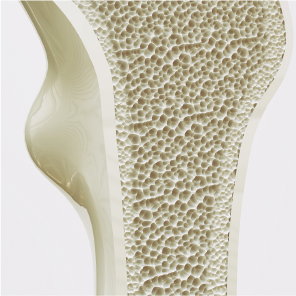Bone Health & Osteoporosis
“Osteoporosis, literally porous bone from the Greek roots, is a disease characterized by low bone mass and structural deterioration of bone tissue, leading to bone fragility and an increased susceptibility to fractures of the hip, spine, and wrist.” Bone loss and osteoporosis, the source of bone fractures (formerly recognized as affecting women) has more recently been identified to affect men. (National Osteoporosis Foundation).
Our bodies go through continuous bone tear-down and rebuilding cycles during the lifetime, where old bone is removed and new bone is formed. Osteoporosis is caused by an imbalance in this cycle; too much bone is broken down and not completely rebuilt. Because bone loss occurs without symptoms until a fracture, osteoporosis is often called a silent killer. Patients most often become aware they have osteoporosis when a fracture is revealed by x-ray after a slight bump or fall.

Stage 1
Women’s peak bone mass is achieved at around age 18. Bones can begin to weaken as early as around age 30. There are often no noticeable symptoms.

Stage 2
Starting around age 35, the rate of new bone formation slows and bone density begins to decrease.

Stage 3
Osteopenia is diagnosed when density decreases enough to be noticed by physician screening.

Stage 4
Osteoporosis is usually diagnosed when the bones begin to break more easily. Some of these fractures may be spontaneous, as bone tissue is eroded. Once you reach this stage, you are likely to notice pain, slumped posture, height loss, and fractures.
The good news is that with proper bone health management you can delay or even help prevent osteoporosis.
1 in 2 women (50%) is likely to experience an osteoporosis-related fracture in their lifetime.
As women (and men) lose bone mass, there is a risk that bone will start to materially change to a point where your health is impacted. However, fractures from bone loss aren’t simply painful. They can restrict movement, causing people to be less active. This is a pathway for reduced lung function and therefore a pathway for the onset of pneumonia, which can be difficult and life-long in it’s impact on breathing function and can be fatal for people in advancing age.
Using Bonesse to help maintain good blood-calcium levels helps keep the essence of you, helps the movement of you, helps the future of you.
40% of women over age 50 already have undiagnosed osteopenia (low bone mass).
As women age, bone loss is a silent condition that sneaks up on you and attacks from within. It’s a cruel side-effect of being female (and sometimes male) of a certain age. This impacts you without your awareness, but it has a definite impact.
Bone, being the storehouse of nutrients in the body, helps regulate metabolic functions of all types. Reduction in bone mass can impact its efficiency and effectiveness, possibly allowing disease to take hold.
The best way to reduce these risks is to keep your bones in the best condition possible through healthy diet, exercise, and using Bonesse.
Coincidentally, people with poor sugar-control related to diabetes should be extra careful as they tend to be 7 times more at risk for bone loss than the average person without diabetes.
Life-altering effects of osteoporosis
Impacts from poor bone health aside from the pain of fractures include reduced mobility and the consequential potential health impacts from being sedentary. The possibility of depression as a side-effect of being socially-isolated may arise as a result. People who have broken a bone may also have poorer overall nutrition. This may be because they have less stamina to prepare or eat meals, especially alone. Of course, having a bone fracture tends to result in a higher risk of further fractures. These issues, among others that have been experienced by many individuals, can collectively become life-threatening.
Am I at risk for osteoporosis?
While you may look and feel fine, you could be at risk for osteoporosis and not know it. Today, more than 10 million people have been diagnosed with osteoporosis, and another 44 million have low bone mass in the U.S. Yet only a relatively small number of men and women with osteoporosis have been diagnosed or treated.
The first step in prevention is to determine whether you are at risk.
A patient’s risk of osteoporotic fracture is associated with bone mineral density and bone quality. Unlike some people’s expectations, bone is not solid, but a structure of tiny pores that allow the free-flow of nutrient-rich blood. Strength and resilience requires the structure to be open enough to allow blood to flow, but with enough strength and density to resist forces from life’s activities. If you think you have one or more risk factors, you should consult with your physician for an Ultrasound or a DXA bone density test. Some risk factors for low bone mass and/or osteoporosis are:
- Are you female?
- Are you over 40?
- Do you have a family history of low-bone mass or fractures?
- Do you have less bone mass than the average individual?
- Are you of white, Southeast Asian, African-American or Hispanic descent?
- Do you consume alcohol in excess?
- Do you smoke or use tobacco?
- Do you drink soda regularly?
- Is your diet heavy in sugars, fats, and processed foods?
- Do you lead a sedentary lifestyle?
Source: (National Osteoporosis Foundation)